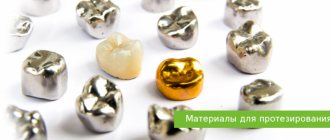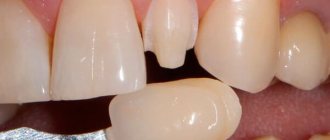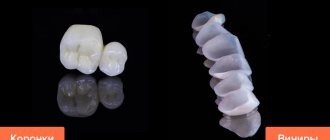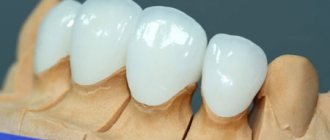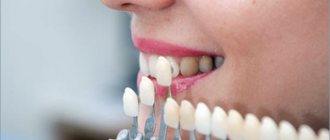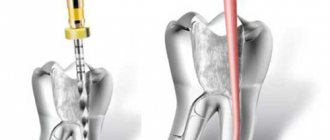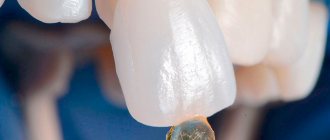Indications for prosthetics
As already noted, prosthetics are recommended to be performed with fixed dentures. Because they are more convenient and reliable. But is it possible to put a removable denture on 1 tooth? Of course, there are practically no contraindications here. The main list of conditions when the need for removable monoprosthetics arises is as follows:
- missing 1 tooth along with the root,
- the natural crown is completely destroyed, but the root is healthy and is being “prepared” for fixation of the stump tab with a crown: during the waiting stage, a removable denture is worn,
- an implant has been installed, but the crown has not yet been fixed on it: the healing (fusion with the bone) of a single implant can last 3-6 months, so a plug is placed on it and the gum is sutured. During this period, a temporary prosthesis is installed for aesthetics and to protect the gums from injury.
The exception is patients with absolute contraindications to fixed prosthetics or implantation. For example, in case of severe diseases of the body, poor blood clotting, intolerance to anesthesia, in childhood, during pregnancy and lactation, the “removal device” is worn for a long time on an ongoing basis.
There are certain indications for installing a removable denture on one tooth, which depend on the type of orthopedic design. Therefore, we will dwell on them in the appropriate sections.
Methods of restoration with composite veneers
Restoring the aesthetics of teeth using composite onlays can be carried out using several technologies, which we will discuss below.
Componeers – ready-made veneers
These are indirect veneers, which, similar to direct plates, can improve the shape and shade of teeth. However, the process of their manufacture is carried out not using individual impressions, but on the basis of ready-made templates, which are shown to the patient. The plates, made of pressed composite material, are applied indirectly. The operational period of such products can reach 7 years.
More about componiers »
Composite veneers - an alternative to whitening?
As you know, the whitening procedure involves applying a thin layer of composite mass to the surface of the tooth. Compared to restorations using composite onlays, plates only improve the shade of the enamel without affecting the shape.
Artistic restoration of teeth
This method allows you to correct the tooth surface with a composite material in the presence of cracks, chips, curvatures and other aesthetic defects. The technique is similar to applying composite veneers. The only difference is the possibility of performing the procedure not only in the frontal region, but also in the masticatory area.
What problems can be avoided?
Let's consider what problems can be solved when using prosthetics with a removable orthopedic design:
- the aesthetics of the smile is restored,
- the gums in the area of the row defect (missing tooth) are protected from injury by hard pieces of food,
- bite relationships and occlusion are preserved: therefore, the antagonist (opposite from above or below) does not move down or up,
- neighboring teeth are not so overloaded during chewing,
- The teeth adjacent to the defect do not move: if you leave a “gap” in the row and do not perform prosthetics, then the “neighbors” on the right and left will gradually shift towards it. Thus, in the future it will be difficult to install a prosthesis or even have to wear a brace system.
Types of orthopedic structures
A removable denture for one tooth can be of 2 types - an immediate prosthesis or “butterfly” and a splinting clasp. They belong to partial orthopedic structures, because placed in case of partial edentia. They are placed in certain clinical situations and have different appearance (as well as purpose). Let's consider their features further.
Don't know what type of prosthetics to choose?
We will help in the selection, advise where to read more information and compare types of prosthetics.
Consultation with an orthopedic doctor in Moscow clinics is free! Call now or request a call
Working hours: from 9:00 to 21:00 - seven days a week
Immediate prosthesis or “butterfly” - characteristics, pros and cons
“Butterfly” is a removable denture for 1 tooth, which looks like a dental crown with pink “wings” or hooks on the sides (4 hooks in total). How does such an orthopedic structure hold up? With these hooks, otherwise called “clasps,” the prosthesis covers the adjacent supporting teeth and is thus fixed. The crown is made of light-colored plastic, and the hooks, which are a continuation of the base, are made of elastic or hard pink polymer. Based on the material from which the artificial gum is made, acrylic and nylon dentures for 1 tooth are distinguished. Moreover, both classic acrylic and the more modern monomer-free material Acry-free (“Acry-free”) can be used.
- indications: suitable for all groups of patients, but only if there are included row defects,
- an absolute contraindication is a terminal defect - the absence of the last molar in the row: in this case, the butterfly clasps on one side will have nothing to attach to,
- advantages: quickly manufactured, easy to install, quick adaptation,
- Disadvantages: the hooks quickly stretch, the fixation of the structure becomes worse - you have to use a special adhesive cream or change the product. Chewing function is not restored very well. They do not stop bone tissue atrophy under the crown (where there is no root). Without load, the bone decreases in size and sags, causing discomfort and decreased aesthetics.
Another contraindication is too young age (up to 2-4 years) and the presence of mental illness, epilepsy. In such situations, the patient may unknowingly swallow the structure.
Read on the topic: immediate dentures - what they are, types, advantages and disadvantages.
Clasp splinting – features, pros and cons
A clasp denture with a splinting function is similar to a traditional one in that a metal arch is placed inside its base - this frame imparts rigidity, facilitates chewing food and correctly distributes the load. Additionally, the design includes claw-shaped or ring-shaped processes made of metal, occlusal pads, with the help of which splinting of mobile teeth occurs. In the upper jaw, this design does not have a massive palatal overlap, but only a thin plate or bridge.
- indications: used for included and end defects, but only in the presence of mobility of the remaining teeth (with periodontitis and periodontal disease),
- advantages: they perform 2 functions at once - they restore missing teeth and stabilize remaining teeth. They distribute chewing pressure well, it is much more convenient to chew with them than with “butterflies”,
- disadvantages: large mass of the structure, does not stop the atrophy of the jaw bone.
Veneers: pros and cons, removable and non-removable, how they are installed
Veneers are a beautiful smile. This is the first association that comes to mind. But do all veneers allow you to change the shape of your teeth for the better and how safe are they? Together with KP experts, we understood all the nuances of veneering
Veneers appeared almost 100 years ago - in the 30s of the twentieth century thanks to the peculiarities of black and white cinema. The smiles of the actors did not look very attractive, they were “gray”, so they had to wear snow-white overlays on their teeth. True, they were poorly attached and quickly came off. But already in the 80s, the Hollywood smile “came” to the general public, because specialists learned to make permanent veneers - rather thin overlays that are securely attached to the teeth and change their appearance. First from plastics and composites, then from ceramics, zirconium dioxide and even from materials with the addition of nanoparticles.
This is an example of how veneers change a person’s smile and the appearance of their teeth.
Ceramic composite veneers. Photo: Smile-at-Once
Veneers can permanently remove dark spots and correct misaligned teeth and even their position. If there are chips, cracks in the enamel or there is a diastema (it is often called a gap - this is a gap between the front teeth), then these problems can also be easily solved with veneers.
But as with any treatment method, there are certain disadvantages that it is better to know about in advance, so as not to completely ruin your teeth and mood.
Removable or permanent: which veneers are better?
Surely many of you know that today not all advertising can be trusted. Of course, there are honest companies that tell everything objectively, without hiding anything. But some literally lure clients, scam them out of money, and then forget about their existence. Sadly, this category also includes those who sell removable veneers...
For only 500–1500 rubles, you are offered an alternative to a beautiful smile - veneers, which can be easily removed and put on, and which do not injure your own teeth. But in fact, these are cheap copies of flexible silicone removable dentures - these are often sold in stores with gifts or entertainment for children. Exclusively as a one-time toy - to scare, for example, someone...
On the left are the veneers from the advertisement. On the right is what they really look like. Photo – Yandex.Zen, user story under the nickname “Wardrobe”.
Everyone who ordered such pads complains that they do not stick, smell extremely unpleasantly like rubber, it is impossible to eat with them, and, in general, it is also impossible to smile. And all because it is a cheap analogue - and not so much veneers as removable dentures. And the most annoying thing is that there is no way to complain or return the money - as a rule, companies selling such veneers immediately send buyers to the “black list”.
“Real veneers are created only in the laboratory and only individually for the patient. And even more - digital programs are used to develop them, which allow you to literally try on a new smile even before the start of treatment. A smile is always modeled for a specific patient - there are no two identical veneers, since each person is individual,” notes Dmitry Sidorov, a practicing orthopedic dentist at the Smile-at-Once clinic with more than 17 years of experience.
What are real veneers and how do the materials used to make them differ?
One of the meanings of the word “veneer” in English is “cladding.” These are really thin overlays that cover the outside of the teeth. In principle, veneers mean all such microprostheses. But as the composition of the ceramics began to change, the names of the overlays began to change.
Let's see what veneers are made of and what they are called today:
• composite are the only veneers that are fixed to the teeth directly in the doctor's office. The material used is similar to that used for filling teeth, and it is applied in layers. But it is better if such veneers are created in the laboratory from individual impressions using special composites enriched with diamond nanoparticles - they are called compositers .
• ceramics are a classic of veneering . Onlays are created in the laboratory by firing from ordinary ceramics (their thickness is about 0.5 mm) or machined on CAD/CAM milling machines from solid ceramic blocks - such veneers will be thinner and better. If nanoparticles are added to the ceramics, then such onlays will already be called nanoneers or nanoveneers .
• Pressed ceramics are advanced ceramics that are made stronger by pressing technology. Such linings are thinner - about 0.3 mm, and also more durable. These are precisely what are often called ultraneers or Russian lumineers (more on the latter a little later). The most popular brands are Empress and IPS E.Max veneers,
• ceramic composite – a modern material consisting of ceramics and composite. Durable enough, allows you to create thin veneers that will last a long time and be repairable,
• zirconium dioxide is the most durable and incredibly aesthetic material. The veneers are individually machined using CAD/CAM technology and then covered with porcelain. The overlays are quite thin, but at the same time strong and look very natural.
We deliberately did not include plastic in the list, because such veneers are used exclusively on a temporary basis - they are placed after your teeth have been ground down and impressions have been taken to make dentures. That is, until the veneers are ready, you will need to spend 2-3 weeks using lightweight plastic analogues.
What are Lumineers?
But lumineers are really not really veneers. Lumineers is a brand of super thin (only 0.2 mm), highly aesthetic and durable overlays. The materials and technologies are patented, but the exact composition is unknown (but it is, of course, safe). This is a Hollywood development - such overlays are created exclusively in the USA under the Cerinate brand. Of course, also individually - all preparation, digital modeling and impressions are made in a Russian clinic. And then you will have to wait about a month and a half while the veneers are developed and then sent to Russia.
The price, of course, is high and greatly depends on the exchange rate of the ruble against the dollar and euro. In addition, lumineers are whiter and often cannot be “matched” to the color of the remaining teeth, so they should only be placed on 6–8 teeth in total. Their proven service life is over 20 years; moreover, the special patented adhesive for attaching lumineers is enriched with many minerals that protect teeth from the development of diseases.
There is another brand of lumineers - Duo PCH. They are created in the same company, but not individually. These are template overlays that are selected for the patient from several variations. Cheaper, but not suitable for everyone.
How should veneers be installed to achieve a perfect smile according to the laws of the “golden ratio”
Today, veneering is not just prosthetics, it is jewelry and even creative, artistic work.
Taking up the research of Pythagoras, Da Vinci actively disseminated the formula of the “golden ratio”, or “mask of beauty”, using it in all his works. And today this data is actively used by artists and designers, as well as doctors in the field of cosmetology, plastic surgery and, of course, dentistry.
What is it like, an ideal smile created according to the parameters of a “beauty mask”?
• the front incisors on the upper jaw, as well as the canines, should be slightly longer,
• the teeth of the upper jaw should be slightly inclined forward, overlapping the lower anterior ones by no more than a third,
• gums in the area of the front teeth should not be noticeable,
• the color and shape of the teeth should be combined with the shape of the lips, skin color, shape of the face and nose.
There are actually a lot of parameters, and each of them must be taken into account when creating veneers that will change your smile.
“One of the modern means of developing a beautiful smile is the use of special programs. For example, Digital Smile Design. First, the doctor models the future smile on a computer, taking into account all the parameters of the patient’s face and his bite, then he agrees on the model, and only after that the process of making the onlays starts. When creating veneers, the shape of the lips and face must be taken into account, bite measurements are taken and compliance with the principles of the “golden ratio”. It’s not enough to create beautiful overlays – you need to make them comfortable to eat with, so that they transform your smile, change the shape of your lips, smooth out wrinkles, and make your face more attractive,” adds orthopedic dentist Dmitry Sidorov.
Who is suitable for veneers and what are their advantages?
Veneers are suitable for those who have the following problems:
• dark shade of enamel, presence of stains, chips, cracks and other external changes that spoil the aesthetics,
• “ingrained” plaque from smoking,
• enamel susceptibility to chipping,
• age-related wear and thinning of enamel,
• spaces between teeth,
• slight curvature of teeth.
The advantages of veneers are that over the course of many years they do not change color and shape, i.e. are not stained - your smile will be beautiful, natural and attractive. There is no need to resort to teeth whitening procedures from time to time. Sensitive teeth will be protected from caries, burns and injury. Veneers can be placed on just 1 tooth, or they can be placed on the entire smile area at once to correct all the imperfections.
Veneers completely change the appearance of teeth, restoring them to their former attractiveness. Photo: Smile-at-Once
What are the disadvantages of overlays?
They really exist, but they are few. The main thing is the need to prepare the upper enamel layer to secure the veneers so that they do not protrude, are held securely, and all teeth are straight. This means that if you decide to remove the veneers, your teeth will have to be restored again with new veneers or crowns, as they will not look presentable. However, if the aesthetics are already compromised, then you can easily turn a blind eye to this minus.
Another disadvantage is the possible gum recession. For example, if the veneer is very thick, if it was created in violation of the execution technique, it does not fit tightly to the surface of the tooth. This means that over time, the boundary between the veneer and your natural tooth may become noticeable. The same problem can be caused by using incorrectly selected hygiene products - for example, a hard brush. Therefore, it is very important to install veneers in clinics that use modern computer modeling technologies, then the risks are minimized. After all, based on the results of such planning, the patient is given temporary veneers (this is an intermediate stage) for some time in order to double-check everything, and the patient can feel the difference, get used to the improved bite, express his wishes and make sure that he gets the desired smile.
Can veneers come off?
If the veneers are professionally created, they will stick to your teeth like a glove. Naturally, you will have to give up sharply biting off hard foods that require strong force (even an apple is better cut into pieces), but, as many patients note, you quickly get used to it. But if you overload your front teeth, bite through the shell, or pull a hard kebab from a skewer, then the linings can really break.
Installation of veneers: stages and time of treatment
Before installing veneers, the oral cavity must be sanitized to remove caries, plaque and tartar. Teeth should be healthy and clean.
The first stage is digital modeling
Using Digital Smile Design and digital impressions, the doctor models veneers taking into account the characteristics of bite relationships, the direction of the teeth, the patient’s facial features, and smiling habits. The patient will be able to try on a new smile on the monitor screen, see the expected result before the start of treatment and agree on all aesthetic aspects. The color and shape of the teeth are additionally verified in daylight on special set palettes.
The second stage is the preparation of teeth
The front surface of the enamel is ground down to a certain depth (0.2–0.6 mm). If it is necessary to eliminate the defect of curvature or bulging, then the level of turning may be higher. During preparation, vertical and horizontal micro-recesses are created - they are needed for better adhesion, that is, fixation of the veneers, because in this way the area of contact with the adhesive composition will be larger. To relieve pain, the procedure can be performed with topical or local anesthesia.
On a note! Is it always necessary to grind down the enamel? For the installation of composite (laboratory), ceramic and zirconium dioxide veneers - yes, because they are thick enough. For others, if indicated, the surface can simply be sanded for better adhesion. If there are crooked teeth in a row, they will definitely have to be sharpened, otherwise they will stick out even after the onlays are fixed.
The third stage is taking control impressions and making onlays
After grinding, control casts of the jaws are sent to the laboratory for production. Temporary plastic veneers will be installed immediately so that the patient can walk around and get used to it, and the doctor can make adjustments - usually within the first week. It will take about two weeks to make permanent ones. If the clinic has its own dental laboratory, then the process may take only 3-5 days, but it is still recommended not to shorten the stage of adaptation to a new smile with temporary veneers in order to take into account all the points. If you choose Lumineers, you will have to wait about a month and a half for them; the longest stage here is shipping.
Stage four - installation
When the onlays are ready, you go to the dentist, the temporary veneers are removed (they will no longer be useful). Then the permanent overlays are first fixed with temporary glue - together with the doctor, you evaluate the result again, and then with the permanent one.
Which doctor should I contact?
If you have chosen restoration of 1-2 teeth with composite material, then you need to contact a dentist specializing in aesthetic restorations. But veneers made in a laboratory are only available to an orthopedic dentist (or “prosthetist,” as patients often call him). Do not confuse this specialist with an orthodontist, who corrects bites using braces, plates or aligners.
Is it worth getting veneers?
There is actually no concrete answer to the question of whether to get veneers or not. Yes, this is an effective and long-term way to correct the situation if you are not satisfied with the enamel, shape of your teeth, or the aesthetics of your smile area. But if you are afraid to grind down your teeth, then the issue of changing your smile is not yet so pressing and you can refuse veneers. But then also from a beautiful snow-white smile. If there is a defect in the curvature of the teeth, then braces or aligners will help to correct the bite. But they will not correct the color and shape.
Rules for care and wearing
How to wear a mono-prosthesis? Removable “butterflies” require regular removal - after each meal or even eating thick yogurt, the orthopedic structure will have to be removed from the mouth and washed in water. There is no need to remove the splinting “clasps” every day; by the way, this can even be dangerous, because there is a risk of severe loosening. With any denture option, you will have to carefully observe oral hygiene - brush and paste twice a day, and soak the denture in a disinfectant solution once a week. You will have to visit the dentist approximately 1-2 times a year for examination and relocation of the structure, because... due to bone atrophy, the fit of the base becomes less dense.
Dietary recommendations limit and even prohibit the consumption of hard foods - chunky hard meat, fresh hard vegetables and fruits (you have to grate them first), toffees and toffees. Therefore, the “butterflies” are weakly fixed and can fly off, and the teeth under the splinting clasps can become very loose.
Ceramic veneers - installation features
Installing ceramic veneers on teeth is a minimally invasive procedure, but due to the need for superficial grinding of the enamel, veneering is irreversible. Keep this in mind when planning to get veneers on your teeth. It will not be possible to remove them if desired and leave the teeth ground; you will need to perform prosthetics with crowns.
The veneering algorithm is as follows:
- The doctor grinds off a small amount of enamel from the front surface of the teeth. Thanks to the preparation, the teeth are reduced and given the necessary shape for the installation of veneers.
- After the teeth are prepared for veneers, the doctor takes impressions and passes the impression to a technician, who makes ceramic onlays in the laboratory.
- The final stage is fixing microprostheses on the teeth and adjusting them to ensure maximum comfort for the patient.
Veneering requires at least two visits to the dentist!
Which option to choose among removable ones?
Which prosthesis[1] should I put on one tooth? It is recommended to select the best option individually, together with an orthopedic dentist. If the speed of prosthetics is important, and the supporting teeth do not have pathological mobility, then it is better to choose a “butterfly” made of acrylic or “Acry-free” for the chewing part of the row. Nylon, of course, is comfortable, but for a very short time, and a stretched product will have to be changed soon. In the presence of pathological mobility, only the splinting clasp remains.
But do not forget that all the options considered are recommended for temporary use only. They are not very securely fixed (especially in the “smile zone”, where the supporting crowns are not so wide) and do not stop bone tissue atrophy. Therefore, it is better to turn to alternatives.
“I wore a bow tie during pregnancy until I could get an implant. It’s not very convenient, and you have to constantly clean it. But I was afraid that without a prosthesis, neighbors would move towards each other, and I would generally suffer later. I was afraid that it would fall out while eating and I would swallow it. Therefore, I had to chew very carefully.”
Olga R., review from baby.ru
What are composite veneers?
Veneers are thin plates that are applied to the surface of the tooth in the frontal area. The need to use such onlays is due to changes in the shade of the enamel or the shape of the dental unit. But if we talk about ceramic products, they can be visualized as thin onlays, but direct composite veneers are not possible. This is due to the specifics of manufacturing, which involves the creation of plates directly in the oral cavity. In this case, a layer-by-layer technique of applying the composite mass is used. In a sense, the technique is identical to artistic restoration of teeth.
Alternatives – fixed dentures and implantation of 1 tooth
If you choose among temporary dentures for one tooth, then the best alternative option is an adhesive fixed bridge. Visually, this is a crown with two small “wings” on the sides that are glued to the supporting teeth. Most often it is placed on the upper or lower front teeth, because in the chewing areas there is too much load and the fixing composition will quickly come off. An adhesive bridge is made of plastic or composite composition.
The classics of permanent fixed prosthetics are bridges. Those made from metal ceramics and zirconium dioxide are the most durable, and ceramic ones look very aesthetically pleasing. The service life, depending on the material, is 7-20 years, but there are also disadvantages. For example, for bridges it is necessary to remove the pulp and grind down the adjacent supporting teeth. And the cost of such a restoration is comparable to the best prosthetic option – a crown on an implant. By the way, the latter will not have such a problem as progressive bone atrophy, since only an implant restores the missing tooth root. And in terms of cost, implantation in the economy and even in the middle class is comparable to prosthetics using a classic bridge. And in terms of service life, a crown on an implant lasts 2-3 times longer.
Zirconium dioxide crown on an implant for the whole 70,000 rubles.
OSSTEM implant (South Korea), individual zirconium abutment, gum former, impression taking.
Creation of a Prettau zirconium crown using 3D modeling technology. Consultation with 2 doctors: an orthopedist and an implantologist for free! Call now or request a call
Opening hours: 24 hours a day - seven days a week
The difference between lumineers and veneers
Lumineers are one of the types of veneers. They are thin plates that are placed on the front teeth to create a beautiful smile. The main difference between lumineers and veneers is the thickness of the plates. Veneers are 0.7 mm thick, while lumineers are only 0.2 mm thick. Due to the difference in thickness, there is also a difference in installation.
Veneers and Lumineers
When installing veneers, the teeth are ground down quite strongly, which makes this process irreversible. Lumineers are installed with minimal grinding of teeth, so after a long time they can be removed in the dentist’s office and the enamel can be restored.
Also, lumineers and veneers have a significant difference in the way they are attached to the teeth. Veneers are installed using dental cement; the installation process takes a long time and will require several visits to the dentist's office. Lumineers are attached to the teeth using a special glue, and they can be completely installed in 1-3 visits.
It's worth noting that veneers have a lifespan of 15 years, while lumineers can last you up to 20 years.
Therefore, if you do not have severe dental defects and want to acquire a “Hollywood smile” for a long time, then you should give preference to lumineers.
Cost of dental restoration
How much does a denture cost for one tooth? In Moscow and the regions, the price of an immediate prosthesis averages 6000-7000 rubles, and a splinting clasp prosthesis costs from 60 thousand rubles. Also, before prosthetics, it is necessary to undergo the removal of tartar and plaque, treatment of existing caries, pulpitis, stomatitis - all these procedures are paid separately.
[1] Abolmasov N.G. Orthopedic dentistry, 2002.
Author: Sambuev B. S. (Thank you for your help in writing the article and the information provided)
Reviews of composite veneers
Above we talked about the pros and cons of composite dental veneers. In general, they are quite suitable for performing aesthetic restorations. In addition, they can be easily fixed on the teeth - in just 1 visit to the doctor, they do not require significant preparation of natural units, can be renewed if necessary, have good aesthetics and an affordable price tag.
However, composite veneers have quite controversial reviews from patients, which is due to the tendency of the material to darken, its short period of use and the need to visit dentistry in the future to polish the material.

